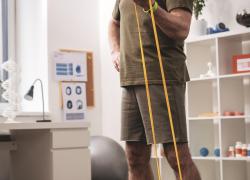From Absence to Engagement: How Student Leadership is Turning the Tide
(NewsUSA) - Across the United States, schools and families are grappling with a troubling rise in chronic absenteeism among students. Chronic absenteeism, defined as missing 10% (18 days) or more school days, has grown significantly since the COVID-19 pandemic. During the 2022-2023 school year, nearly one in three students was chronically absent, with even higher rates for students with disabilities, students of color, and students learning English as a second language.
- Across the United States, schools and families are grappling with a troubling rise in chronic absenteeism among students. Chronic absenteeism, defined as missing 10% (18 days) or more school days, has grown significantly since the COVID-19 pandemic. During the 2022-2023 school year, nearly one in three students was chronically absent, with even higher rates for students with disabilities, students of color, and students learning English as a second language.
Chronic absenteeism, largely driven by student disengagement, has serious implications for academic success. When students feel disconnected from their school, they are less likely to attend, and their academic performance suffers as a result. Chronically absent students are more likely to fall behind in their studies and are four times as likely to drop out of high school.
To address this, superintendents, principals, and educational administrators are exploring innovative strategies to foster a stronger sense of belonging at school and boost student engagement.
Igniting Peer Leadership to Boost Engagement
Many schools have discovered that mentorship programs, peer-to-peer relationships, and social-emotional learning initiatives can help students feel more connected to their school communities and improve attendance rates. By leveraging one of the most underutilized resources in schools—students themselves—through peer mentorship and leadership programs, school communities are able to cultivate supportive, caring environments that motivate students to attend and engage.
One organization, Center for Supportive Schools (CSS), has seen success with its Peer Group Connection (PGC) program, which fosters peer leadership and mentoring. This program has proven effective in boosting attendance and engagement across grade levels.
“Chronic absenteeism continues to be an ever-present challenge, but it’s not one schools have to face alone,” shares Center for Supportive Schools Chief Executive Officer, Dr. Jonathan Mathis. “By empowering students as leaders and mentors, we can foster engagement, connection, and belonging. Through peer leadership, schools can build a strong culture where every student feels supported, motivated, and ready to succeed.”
In a 2018 study of more than 8,000 students, CSS found that those who participated in PGC attended school an average of six more days than students who did not. A year after completing the program, participants attended between 2.4 and 7.8 more days of school than their peers. “My peer leaders motivate me to get better grades and to keep coming to school,” shared one PGC participant.
By encouraging students to take on leadership roles and strengthening peer relationships, PGC helps students develop a stronger sense of identity with their school community, leading to improved academic outcomes. Additionally, the program equips students with valuable leadership skills that will serve them well after graduation.
Elevating Student Voices to Foster Belonging
Another CSS program, known as When Students Lead (WSL), empowers groups of peer advocates to conduct research, identify pressing issues within their school community, present solutions, and implement student-led campaigns to address those issues.
This program helps students feel more connected to their peers and their community by giving them a leadership role on issues that matter most to them. It also fosters important leadership skills, including research, data analysis, critical thinking, collaboration, negotiation, problem-solving, and decision-making.
Making A Lasting Impact on the Next Generation
The evidence is clear: when we empower students to lead, connect, and support one another, their attendance and performance improve. By implementing peer-to-peer programs, schools can reduce chronic absenteeism while creating a stronger sense of community, improving student outcomes, and providing students with crucial leadership skills that will benefit them throughout their lives. For more information, visit www.supportiveschools.org.



 - If you’re a pet parent who considers your furry companion a true family member, you’re not alone. Pet ownership is bigger—and more indulgent—than ever. The pet industry surpassed $152 billion in 2024, and is expected to top $250 billion by 2030, according to the
- If you’re a pet parent who considers your furry companion a true family member, you’re not alone. Pet ownership is bigger—and more indulgent—than ever. The pet industry surpassed $152 billion in 2024, and is expected to top $250 billion by 2030, according to the 
 What’s fueling this growth? According to the pet products pros at APPA, it is evolving demographics. Gen Z is quickly catching up to the Millennials in pet ownership, bringing their digital-savvy shopping habits into the pet care world. Also, men are adopting cats at a brisk pace, proving that feline companionship isn’t just for ladies anymore.
What’s fueling this growth? According to the pet products pros at APPA, it is evolving demographics. Gen Z is quickly catching up to the Millennials in pet ownership, bringing their digital-savvy shopping habits into the pet care world. Also, men are adopting cats at a brisk pace, proving that feline companionship isn’t just for ladies anymore.
 Mental Enrichment: The Key to a Happy Pet
Mental Enrichment: The Key to a Happy Pet
 - Child care remains a top priority—and a significant financial investment—for many families. Fortunately, several financial assistance programs are available around the country to reduce the burden of child care tuition for parents while ensuring children have access to a high-quality early learning environment. These programs, available through military, state, federal, employer, and other channels provide essential support for families in need of affordable child care options.
- Child care remains a top priority—and a significant financial investment—for many families. Fortunately, several financial assistance programs are available around the country to reduce the burden of child care tuition for parents while ensuring children have access to a high-quality early learning environment. These programs, available through military, state, federal, employer, and other channels provide essential support for families in need of affordable child care options.
 - Troy Ita’s life was turned upside down by diabetes. Thankfully, he doesn’t have to compromise lifestyle or family time with the help of groundbreaking technology.
- Troy Ita’s life was turned upside down by diabetes. Thankfully, he doesn’t have to compromise lifestyle or family time with the help of groundbreaking technology. -
-  “Onward, Ye Heroes” by C.S. Brown
“Onward, Ye Heroes” by C.S. Brown “A Life in Frames” by Leonora Ross
“A Life in Frames” by Leonora Ross “Estranged: How Strained Female Friendships Are Mended or Ended” by Susan Shapiro Barash
“Estranged: How Strained Female Friendships Are Mended or Ended” by Susan Shapiro Barash “Horrible Women, Wonderful Girls” by Julie Ann Sipos
“Horrible Women, Wonderful Girls” by Julie Ann Sipos -
-  If you put on socks this morning but skipped the sunscreen, you’re doing it wrong — at least according to a new nationwide campaign launched on World Health Day earlier this spring.
If you put on socks this morning but skipped the sunscreen, you’re doing it wrong — at least according to a new nationwide campaign launched on World Health Day earlier this spring.
 - As the cold of winter fades, spring brings a fresh sense of renewal—and for many, it’s the first time in months they’ll be showing off their legs again. But for some, the thought of revealing their legs can come with hesitation. This may be especially true for those with varicose veins.
- As the cold of winter fades, spring brings a fresh sense of renewal—and for many, it’s the first time in months they’ll be showing off their legs again. But for some, the thought of revealing their legs can come with hesitation. This may be especially true for those with varicose veins. - For more details, including important safety information, on VenaSeal, visit:
- For more details, including important safety information, on VenaSeal, visit:  - For more details, including important safety information, on VenaSeal, visit:
- For more details, including important safety information, on VenaSeal, visit:  - For more details, including important safety information, on VenaSeal, visit:
- For more details, including important safety information, on VenaSeal, visit: 




